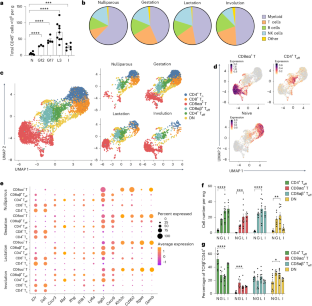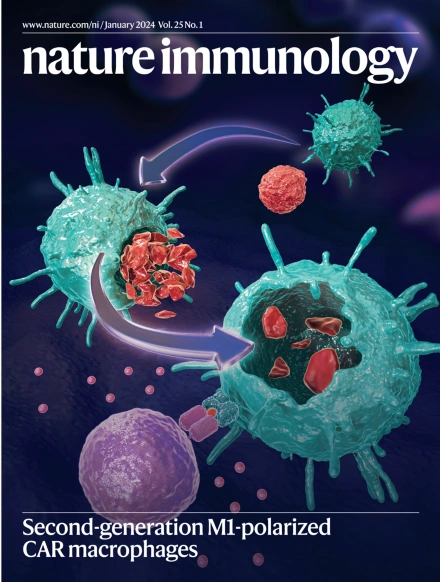Mammary intraepithelial lymphocytes and intestinal inputs shape T cell dynamics in lactogenesis
IF 27.6
1区 医学
Q1 IMMUNOLOGY
引用次数: 0
Abstract
Pregnancy brings about profound changes in the mammary gland to prepare for lactation, yet immunocyte changes that accompany this rapid remodeling are incompletely understood. We comprehensively analyzed mammary T cells, revealing a marked increase in CD4+ and CD8+ T effector cells, including an expansion of T cell receptor (TCR)αβ+CD8αα+ cells, in pregnancy and lactation. T cells were localized in the mammary epithelium, resembling intraepithelial lymphocytes (IELs) typically found in mucosal tissues. Similarity to mucosal tissues was substantiated by demonstrating partial dependence on microbial cues, T cell migration from the intestine to the mammary gland in late pregnancy and shared TCR clonotypes between intestinal and mammary tissues, including intriguing public TCR families. Putative counterparts of mammary IELs were found in human breast and milk. Mammary IELs are thus poised to manage the transition from a nonmucosal tissue to a mucosal barrier during lactogenesis. Here Ramanan and colleagues provide an analysis of mammary T cells during late pregnancy and lactation. This revealed an increase in intraepithelial lymphocytes in the lactating mammary gland, which was driven by thymic and intestinal inputs and was sensitive to changes in the microbiota


乳腺上皮内淋巴细胞和肠道输入形成乳发生中的T细胞动力学
怀孕给乳腺带来了深刻的变化,为哺乳做准备,然而伴随这种快速重塑的免疫细胞变化尚不完全清楚。我们全面分析了乳腺T细胞,发现CD4+和CD8+ T效应细胞显著增加,包括T细胞受体(TCR)αβ+CD8αα+细胞的增加,在妊娠和哺乳期。T细胞定位于乳腺上皮,类似于粘膜组织中典型的上皮内淋巴细胞(IELs)。与粘膜组织的相似性被证实为部分依赖于微生物线索,妊娠后期T细胞从肠道迁移到乳腺,以及肠道和乳腺组织之间共享的TCR克隆型,包括有趣的公共TCR家族。在人类乳房和乳汁中发现了假定的乳腺IELs对应物。因此,乳腺IELs可以在乳发生过程中管理从非粘膜组织到粘膜屏障的转变。
本文章由计算机程序翻译,如有差异,请以英文原文为准。
求助全文
约1分钟内获得全文
求助全文
来源期刊

Nature Immunology
医学-免疫学
CiteScore
40.00
自引率
2.30%
发文量
248
审稿时长
4-8 weeks
期刊介绍:
Nature Immunology is a monthly journal that publishes the highest quality research in all areas of immunology. The editorial decisions are made by a team of full-time professional editors. The journal prioritizes work that provides translational and/or fundamental insight into the workings of the immune system. It covers a wide range of topics including innate immunity and inflammation, development, immune receptors, signaling and apoptosis, antigen presentation, gene regulation and recombination, cellular and systemic immunity, vaccines, immune tolerance, autoimmunity, tumor immunology, and microbial immunopathology. In addition to publishing significant original research, Nature Immunology also includes comments, News and Views, research highlights, matters arising from readers, and reviews of the literature. The journal serves as a major conduit of top-quality information for the immunology community.
 求助内容:
求助内容: 应助结果提醒方式:
应助结果提醒方式:


